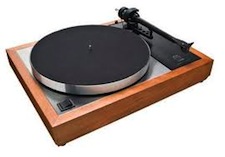It’s the time of year for saving money!

It could be successfully argued that the Linn Sondek LP12 turntable is the most successful high end source component in the history of audiophila. Nearly 30 years after the advent of the Compact Disc, the LP12 still sells in respectable volumes to those who seek the best sound from vinyl. The LP12 is the Wilson WATT Puppy of turntables as it was introduced with fantastic performance, was upgradable (to some level or another) for years and was able to stand the test of time. Ask anyone with an LP12 and they will talk about it as a luxury goods item, like a vintage Patek Philippe watch they would pass down to their heirs. It’s an emotional buy.
B
ack in the day when the Linn LP12 was making its mark on the industry – Linn made the argument that your system was only as good as your source. The American or “West Coast” outlook on systems was that your speakers are the most important element of your audio system and Linn set out to get people thinking about their collective source components. Truth be told – your system is only as good as its weakest link. If you have a $20,000 source component running through a $10,000 stereo preamp into a pair of 400 watt per channel audiophile grade $20,000 monoblocks wired with $10,000 in cables but are rocking a pair of $500 Internet-direct speakers – you can easily see the weakness in your rig. The goal of building an incredible audiophile system should be to build a balanced system and to enjoy the upgrade path. If your first speakers are Revel Ultima Salon2s and your first amps are Mark Levinson no. 436s, it’s as if your Dad bought you a Porsche 911 for your 16th birthday. There isn’t much room up the food chain from where you started.
Today’s source and source material is very different than back in the day of Linn. Audiophiles are using Apple sources. They are streaming Pandora and Internet radio in low resolution formats via various devices including Blu-ray players (http://hometheaterreview.com/blu-ray-player-reviews-and-information/). Gone in many ways are the subtle analog differences that come from changing a cartridge or a tonearm (unless you rock a turntable too – which many audiophiles do). Today’s source upgrades are coming from modifying or augmenting Apple’s cheapie internal DACs with something external. Other upgrades come from using the Special Edition audiophile analog outputs that come from upper-level Blu-ray players like the Oppo Digital and Cambridge Audio or NuForce Oppo Edition.
Years ago when I was a 19 year old selling audiophile gear at Christopher Hansen Ltd. back in the early 1990’s, my classic system was a pair of Wilson WATT Puppy 3.2s with an entry level Acurus amp, a Rotel CD player and entry level Transparent Audio cable. It priced out at about $16,000, which was expensive for the time but still do-able for many Beverly Hills shoppers. The setup looked great and sounded fantastic for the money. Did said system sound better with Mark Levinson electronics and better Transparent cables? Hell yes it did, but that was the upgrade path for a later date. This back loaded system gave the most bang for the buck for the customer, including the aesthetic that they liked, but was admittedly shy on power and front end. The question is: With record labels today still refusing to sell audiophiles meaningful 24/96 material despite the 40 percent market penetration of an HDCP copy-protected Blu-ray disc format – should today’s audiophile abandon the Linn concept and backload a system for the “West Coast” configuration – meaning making one’s system more speaker-centric?
Despite the early retail success that I had with the Wilson/Acurus system that I sold to many, back in the day – I still agree with Linn or at least in the concept that a system needs to ultimately be balanced in its configuration. Each step in the progression of one’s audiophile system should be enthusiastically planned, researched and enjoyed. That is part of the fun of the hobby and should be embraced. Road trips to the Rocky Mountain Audio Fest or to an out of town dealer are tantamount to going to see your favorite sports team on location. Saving for that next lustful component can change from a source component upgrade to bigger speakers or adding a subwoofer or adding room treatments or going back to the beginning and replacing one of your early investments. Your system is as good as the sum of its parts in your room (do not forget your room acoustics). The physical design of your room and your budget will be limiting factors of the progression of your system. Budgets can be expanded over time and rooms can be improved (just call ASC Tube Traps and talk to those guys – they love to help). The most important part of the process is to actually enjoy the ride. Who knows, maybe someday you will own a Linn LP12 as one of your source components? That would be rocking in style.
]]>






The Linn philosophy doesn’t change.
Your source is still the most important. No matter it’s analog or digital front end, it’s still garbage in, garbage out. In digital audio, the DAC is the component closest to the software (analogous to your turntable). All Linn was saying is that when you have a balanced system and looking for another round of upgrade, start with the end closest to the software.